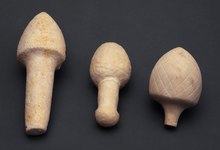Lapa do Bugio
Lapa do Bugio (also called Isabel station ) is a natural cave on the west side of the Arrábida Natural Park , west of Setúbal in Portugal , which was used as a burial site by an agricultural population from the Neolithic to the Copper Age (4th to 3rd millennium) .
The cave is located at Sesimbra , 500 m from the village of Azoia and 150 meters above sea level and was discovered by Rafael Monteiro in 1957. In the same year, the excavations of the Archaeological Museum of Sesimbra began. The cave measures 9.8 × 8.8 m and is 4.4 m high and has a triangular entrance area. The grave goods lay under flat plates along the walls up to the center of the cave.
The following were found: Limestone idols with traces of decorations, ceramic shards, bone tools (two "Idols of the Almeriense type" rare in Portugal and the sculpture of a pair of rabbits), several slate idols , pine cone idols ( Portuguese Idolos de Calcário or "pinhas") made of sandstone , and polished stone tools and discounts . These included trapezoidal microliths , arrowheads with a stalked base, concave and straight, several blades and two piles of rock crystal (minerals that do not occur in the region).
literature
- Rafael Monteiro & E. Serrao da Cunha: Isabel Station (Necróplole prehistoric Azoia) and Memory Proceedings of the First National Congress of Archeology, Lisbon, 1959.
- O. Ferreira da Veiga: Manifestations of the art of burial equipment from Portugal. Eneolítico, Journal of Guimarães
Individual evidence
- ↑ Sobre os ídolos de calcário - "pinhas" - do Calcolítico da Estremadura - Algumas considerações sobre dois exemplares da Lapa do Bugio (Sesimbra)
Web links
Coordinates: 38 ° 25 '56.3 " N , 9 ° 10' 12.8" W.
